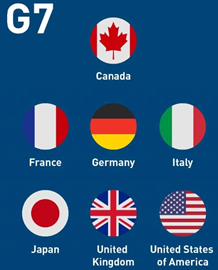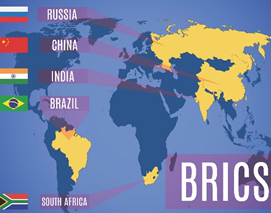

Context
Data shows that, beginning 2020, the BRICS nations as a whole now contribute more towards global Gross Domestic Product (GDP) than the G7 industrialised nations do, in terms of purchasing power parity (PPP).
Key-highlights of IMF’s Report
- The International Monetary Fund’s (IMF) GDP data across countries over time depicts that since 1992, there has been a steady decline in the share of the G7 in global GDP, and an equally steady rise in the contributions of the BRICS nations.
- By 2019, the contributions of the two groupings had become nearly equal, with the G7 contributing 31.5 per cent to global GDP, and the BRICS accounting for 30.7 per cent.
- It was in 2020, however, that the G7-BRICS dynamic flipped. That year, the BRICS (31.4 per cent) overtook the G7 (30 per cent).
- Expansion: The BRICS is also expanding – Bangladesh, Egypt and the UAE have all just joinedthe BRICS New Development Bank, with numerous other countries poised to do the same.
A quick comparison
|
BRICS |
G7 |
|
The BRICS countries comprise Brazil, Russia, India, China, and South Africa, and represent the largest developing economies. |
The G7 are the largest industrialised economies and consist of the US, the UK, Germany, France, Japan, Italy, and Canada. |
|
The G7 countries have historically been among the largest economies in the world.
|
The BRICS nations — especially China and India — have been and continue to be the most populous.
|
What factors are responsible for the growth?
- COVID-19 Pandemic
- Russia-Ukraine War
- Macroeconomic stability
- responsible monetary policy
- decreased sovereign debt
- increasing international reserves
What are the likely impacts?
|
Persistent challenges (for BRICS)
|
- The combined economies of Brazil, Russia, India and China (BRICs) could emerge as a dominant economic block in the world.
- The growth increases the opportunities for economic and political influence in order to:
- strengthen and reform the multilateral system, including international economic organizations, to ensure that it is more inclusive, democratic and representative
- to enhance participation of developing countries and states with emerging markets in the process of international decision-making
Role of BRICS
- Change the world economic system-BRICS is actively involved in the efforts to change the world economic system by increasing the number of non-Western states in international financial institutes despite frantic opposition by the traditional distributors of world money.
- New Development Bank and Currency pool-The BRICS countries decided to create the $100 billion BRICS Development Bank and a reserve currency pool worth over another $100 billion to offer an alternative to countries in the non-Western world when it comes to choosing the sources of funding for development or coping with serious economic crises.
- Alternative to West-The current crisis in Ukraine will consolidate BRICS as the group will make further efforts to become a real alternative to the West to create a real multipolar world.
Understanding Western Differences of BRICS
- Socialist Tendencies-Brazil, which represents Latin America and has strong left socialist tendencies, disagrees with the West on social issues.
- Abetting the old order-The situation in South Africa where the local communists belong to the ruling coalition while the West is accused of abetting the old order.
- Repelled by moral values-In Russia and India, people are not so much repelled by the political as by the moral values of the West.
|
Organisational Info About BRICS
Group of Seven (G7)
|



